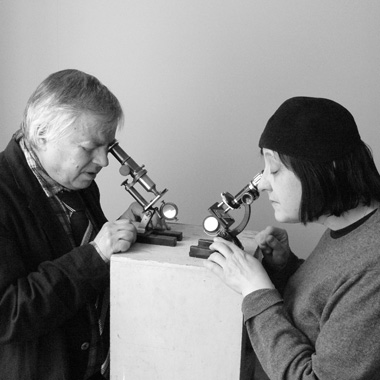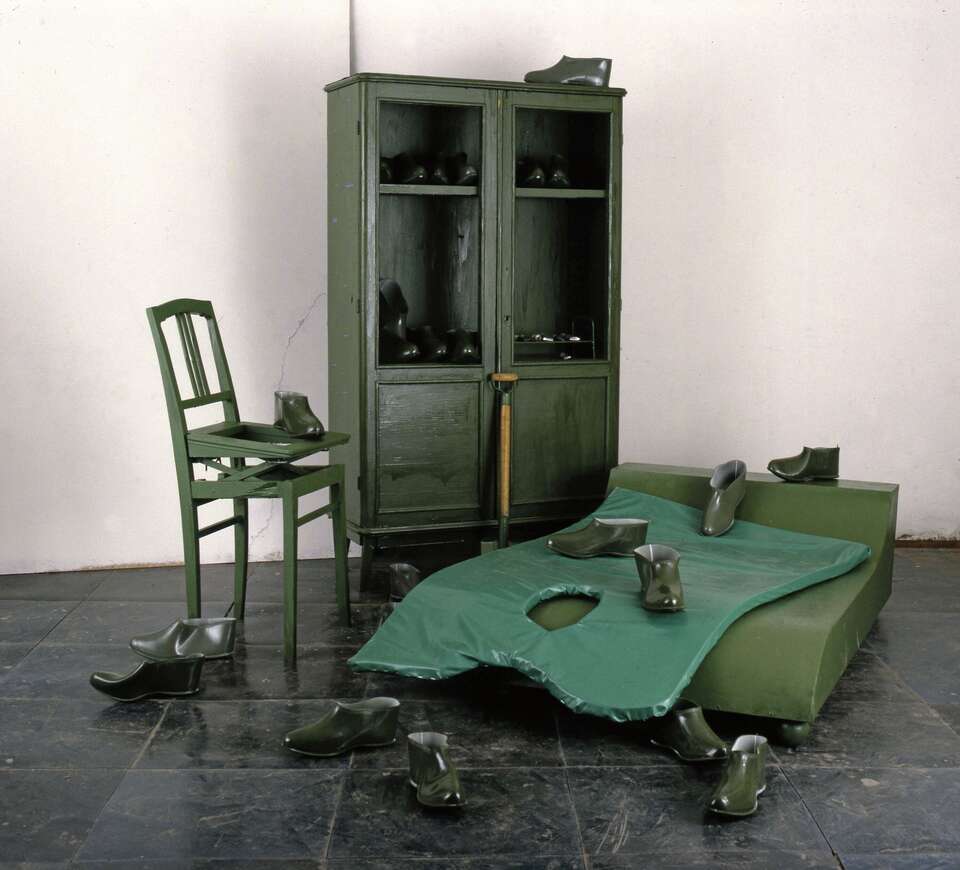The Sleep of Painting Produces Monsters
The title of the installation, The Sleep of Painting Produces Monsters, echoes Goya’s famous engraving The Sleep of Reason Produces Monsters, which depicts a sleeping artist haunted by ghosts. Makarevich’s work features no subject; instead, it’s the objects and furnishings that act. Thus, painting itself becomes the imaginary sleeping subject here, and the viewer must discover the hidden mechanisms of its life.
The large sofa made by Makarevich brings to mind Sigmund Freud’s couch, on which his patients lay during psychoanalytical sessions, while also referring to similar furniture in famous paintings of the past such as Portrait of Madame Récamier by Jacques-Louis David and René Magritte’s Perspective: Madame Récamier by David. On the sofa, Makarevich has placed a large, soft painter’s palette reminiscent of the surrealists’ flowing forms.
The spring-loaded chair is not a piece made by the artist, but a found object, and its original function is unknown. In any case, this chair is no longer intended for sitting but forms part of the composition as one of the actors. Chief among these actors is, of course, the closet.
This piece of furniture occupies a special place in the repertoire of Moscow conceptualists. Ilya Kaba-kov dedicated one of the albums in his Ten Characters series to Primakov-in-the-Closet, an invented boy who created his world within a closet’s walls and eventually dissolved in this tiny space. According to Makarevich, an important source for the formation of the Moscow conceptualist program was the absurdist poetry of Daniil Kharms, who once said: “Art is a closet.” Moreover, one cannot help but think of the famous “My dear and honored bookcase!” monologue uttered by Gaev in Chekhov’s The Cherry Orchard [in Russian, bookcases, closets, cupboards, and wardrobes are all called shkaf]. In Makarevich’s installation, the closet is an animate subject, a portal to another world, a bottomless receptacle for fantastic objects. It is only ajar, but we can discern something on a shelf: a tiny toy cot, and on it, tubes of oil paint, laid out carefully like newborn babies. They symbolize the sleep of painting, an art form which in the second half of the 20th century gave way to new practices and new forms of artistic activity: objects, performances, installations. Arguably, it went into “sleep mode.”
In a sense, Makarevich’s work is a materialization of painting: the birth of spatial composi-tion (that is, of installation) from the “spirit” of painting. All the objects here are of a dull official green, like in Soviet institutions, but at the same time, this colour is traditionally associated with death and resurrection. Generated by surrealist dreams, filtered through the experience of Soviet communal esthetics, the “monstrous” installation intrudes into the real world.
The sense of coarse reality is intensified by the presence of rubber slippers. They seem to multiply and scurry around, as if trying to occupy as much space as possible, so as to leave a trace and gain a foothold in the schizophrenic space of the installation.
The Treachery of Images is the title of one of René Magritte’s key paintings, and it is through such “treachery” that Makarevich’s installation demonstrates a “genetic” connection between surrealism and contemporary conceptualist practices. In 1990, Makarevich’s installations featured in the exhibition Toward the Object, organized by Andrei Erofeev; in the same year, he and Elena Elagina created the installation Gerantomachy for a large-scale group exhibition with the characteristic title Shizokitai: Hallucination in Power, reflecting the decay of Soviet civilization, events that appeared like an incredible phantasmagoria and were followed by an invasion of reality.
Natalia Sidorova, with Kirill Svetlyakov



